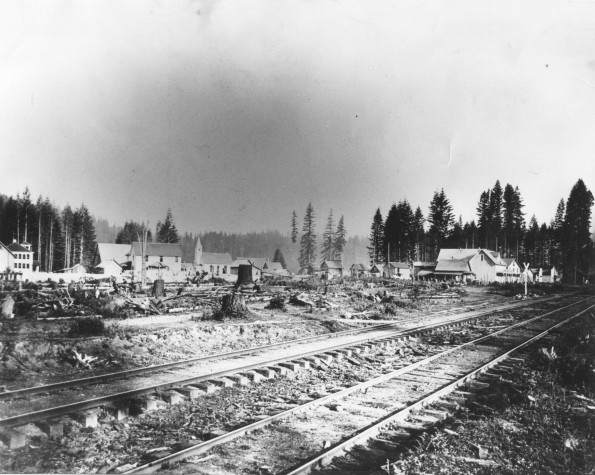Jobs in the timber business have mostly vanished but nostalgia for the old times still thrives in the Yacolt/Amboy/Chelatchie Prairie area in northeast Clark County.
Some of the talk involves the saloons and thirsty Yacolt loggers of the early 1900s, when the town boasted a hospital, high school and even a newspaper. Those were the days when Weyerhaeuser Timber Co. was the backbone of the economy. Later, International Paper Co. operated mills at Chelatchie.
And small mills operated through the northern part of Clark County for a long time.
“There are a certain number of loggers yet,” said Wayne Sutton of Wayne’s Saw Shop of Amboy, but they don’t work regularly.
The link to the woods industry is reflected in the annual logging show at Amboy’s Territorial Days, which is scheduled this weekend. And people who want to see saws used in the woods in earlier times can view a big display at Sutton’s shop cross-cut saws (“misery whips,” some people called them) and primitive chain saws.
In the earliest days, before timber could be marketed, the trees were considered just a nuisance, something to get rid of as soon as possible so cabins and garden spots could be provided.
Although remote from the Columbia River and Vancouver, land in the Yacolt/Amboy area was targeted by settlers as early as the 1850s, the time of the earliest donation land claims.
Stores were distant
Trips to bigger towns were a rarity, as indicated in an interview with Charles Olstad, Amboy civic leader, more than 20 years ago. He said his father hauled supplies from Vancouver once a year, before winter “staples we’d need through the year.”
The Olstad family raised its own potatoes and vegetables. Most early-day residents kept a few cows, and would sell the cream. “Everybody raised a few hogs too,” said Olstad.
Amboy was the earliest town to develop. The Amboy post office was established in 1886 with Amos Ball, a mill operator at the Chelatchie crossing of Cedar Creek, as postmaster.
Of all events in northeast Clark County history, the most memorable was the great Yacolt fire of September 1902, which ravaged many square miles of the Cascade Mountains and reached Yacolt.
“People would talk about the smoke being so thick the chickens went to roost,” thinking it was night, said Ruth Ham, a long-time Amboy resident.
That was the same year the railroad was constructed to Yacolt. A post office was opened there and named Garner, for a local storekeeper. Yacolt had a post office earlier, but it closed in 1896, a year after it was opened. In 1904 the post office was renamed Yacolt, and the community was booming.
Thousands of huge, blackened skeleton trees left-overs from the massive fire loomed on the Yacolt horizon, providing the impetus for a big logging effort.
Railroad important
Ross Shepeard, a district forest ranger who researched Yacolt history in the 1930s, said the Weyerhaeuser Timber Co. began operations when the railroad entered Yacolt, and continued until 1925.
“By the latter date they had completed the cutting of all Weyerhaeuser timber except for a few hundred acres located on the hill west of town,” Shepeard wrote. “This was later logged by the Murphy Timber Co.
“When Weyerhaeuser started operations, the company was known as the Twin Falls Logging Co. The name was derived from a small falls on Big Tree Creek, which was about three miles east of town. In 1910 the Twin Falls Lumber Co. was discontinued and the Weyerhaeuser Timber Co. became known as the Clark County Timber Co. under which name it operated until it closed in 1925.
“The company employed in the neighborhood of 300 men, the majority of them being transient loggers. The office force, machine shops and railway crews supplied the larger part of the town’s population.”
Yacolt turned considerably quieter after the Weyerhaeuser era.
In the meantime, Amboy continued active. “It was quite a little place,” with a variety of businesses, said Ruth Ham. But separate fires in Lower and Upper Amboy wiped out a good part of the business district.
Mills active
When International Paper Co. (IP) moved in there was “a lot of hustling and bustling” as the result of the big plywood mill and saw mill at Chelatchie, said Ham. “There were a lot of men in the woods besides.”
The Longview, Portland and Northern Railroad, now known as the Lewis and Clark Railway, had been extended to Chelatchie and served IP. However, the mill activity lasted only from late 1960 to 1979, and many workers left the area after jobs vanished.
Lately, new residents have moved in, and Yacolt especially has been a magnet because of its water system and sewer lines. Yacolt population, 544 in 1980 and 600 in 1990, had jumped to 812 by this year.
Many motorists also pass through to Campers’ Hideaway and other recreation areas along the Lewis River. But a big share of metropolitan area residents “don’t even know what’s out here,”
Ham contends.
Long-time residents have been adjusting to new neighbors.
For Wayne Sutton of the saw shop, the change is reflected by an increased business in lawn mowers, brush cutters and trimmers. Saws were practically all his business formerly, but now account for only one-half.
“But brush grows profusely in this area, and people still need their saws to cut it,” Sutton said.
Even with the present big changes, residents pay some attention to the past, and the most notable example is the planned rehabilitation of an old church into North Clark Historical Museum at Amboy.
Barbara Waggener, a leader in starting the project, said the museum plan started as a state Centennial project. The museum is seeking grants to restore the church, and also earning money this month through cooking at celebrations.
The museum board and volunteers sold food at the sixth annual Mount Tum Tum Native American Encampment in Amboy during the past weekend, and will serve chicken dinners at Territorial Days during the coming weekend.
